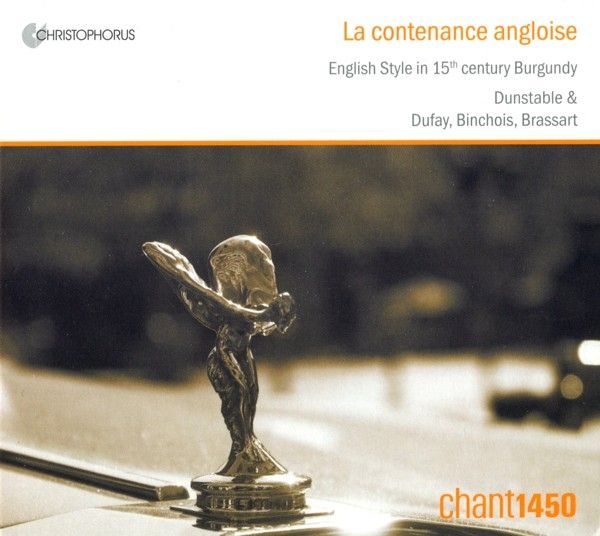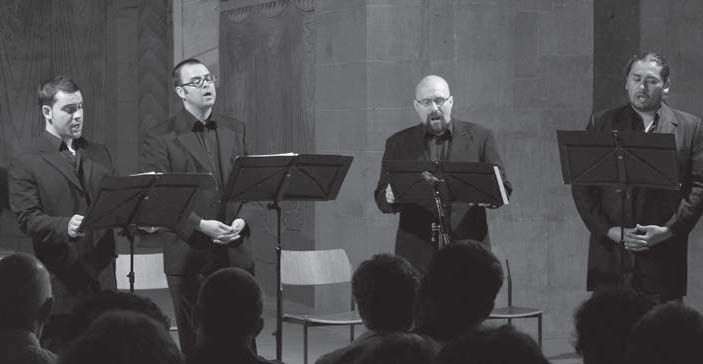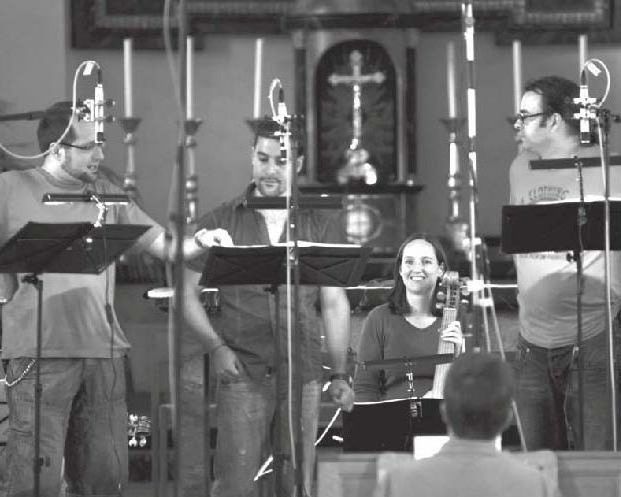La contenance angloise / chant1450
Der englische Stil in der Musik Burgunds im 15. Jahrhundert

medieval.org
chant1450
Christophorus CHR 77332
2010
1. Gilles BINCHOIS (c.1400-1460). Ave regina cælorum [1:55]
2. Guillaume DuFAY (1397-1474). Ave regina cælorum [1:25]
John DUNSTAPLE (c.1390-1453) · Chansonnier Cordiforme
3. O rosa bella [1:47]
4. Guillaume DuFAY. O tres piteulx ~ Omnes amici eius [3:07]
5. [4:03]
Galfridus de ANGLIA (c.1444). Che farò io
Guillaume DuFAY. Kyrie (Missa «Sancti Antonii Viennensis»)
6. Gregorian chant. Ave regina
cælorum [1:30]
Conrad PAUMANN (c.1410-1473) · Buxheimer Orgelbuch
7. O rosa bella [1:49]
8. Leonel POWER (-1445). Ave regina cælorum [2:10]
Gregorian chant. Commune Beatæ Mariæ Virginis
9. Gaudeamus [2:46]
10. Gilles BINCHOIS. Te Deum [2:42]
11. Robertus de ANGLIA (c.1454-c.1474). El mal foco arda [1:34]
12. Guillaume DuFAY. Supremum est mortalibus [6:23]
13. Guillaume DuFAY. Alma redemptoris mater [3:45]
Conrad PAUMANN · Buxheimer Orgelbuch
14. Annavasanna tertia [2:03]
Gregorian chant. Commune Beatæ Mariæ Virginis
15. Concupivit [1:57]
16. John DUNSTAPLE. Speciosa facta es [1:53]
17. Guillaume DuFAY. Flos florum [3:15]
18. John DUNSTAPLE. Salve scema sanctitatis ~ Salve salus
servulorum [6:46]
Conrad PAUMANN · Buxheimer Orgelbuch
19. Sanssoblier [2:19]
20. Gregorian chant. Regina
cæli [1:40]
John DUNSTAPLE · Marc Lewon
21. Puisque m'amour [2:43]
22. Johannes BRASSART (c.1420-c.1445). O flos fragrans
[3:06]
Conrad PAUMANN · Buxheimer Orgelbuch · Masako Art
23. Fortune, alas [2:05]
Gregorian chant. Commune Beatæ Mariæ Virginis
24. Ave Maria gratia plena [1:46]
25. Guillaume DuFAY. Aura luce [3:12]
26. Gregorian chant. Salve Regina [1:40]
Johannes BRASSART · Marc Lewon
27. Regina cæli [3:32]
Gregorian chant. Commune Beatæ Mariæ Virginis
28. Beata viscera [0:48]

chant 1450
Javier Robledano Cabrera · Countertenor
Daniel Manhart · Tenor
Juan Díaz de Corcuera · Tenor
Ismael González Arróniz · Bass
Nicolas Savoy · Tenor (Gregorianik)
Elizabeth Rumsey · Fidel
Masako Art · Harfe
Marc Lewon · Laute, Fidel, Quinterne
Gregor Ehrsam · Orgelpositiv
Executive Producer:
Joachim Berenbold
Recording: 11.-15.8.2009, Kirche St. Germanus, CH-Seewen SO
Recording Engineer: Roland Kupferschmied, aTonArte, CH-Wald ZH
Editing: Daniel Manhart, Home Productions, CH-Rapperswil
Mastering: Roland Kupferschmied, aTonArte, CH-Wald ZH
Project Supervision: Esther Ineichen
Orgelpositiv von Siegfrid Jud, CH-Mels, 1980
Booklet Editor: Joachim Berenbold
Artist Photos: Chrsitof Thurnherr
Cover Photo: "Engle", Peter Mertz
Translations: English- christopher Cartwright & Godwin Stewart / Franšais- Sylvie Coquillat
Ⓟ + © 2010 MusiContact GmbH, Heidelberg, Germany

La contenance
angloise
Der englische Stil in der Musik Burgunds im 15. Jahrhundert
von Daniel Manhart
Die
englische Musik erregte zum ersten Mal beim Konzil von Konstanz
(1414-1418) Aufsehen, einem der wichtigsten Angelpunkte des
europäischen Kulturaustauschs am Anfang des 15. Jahrhunderts.
Zahlreiche Musiker, geistliche und höfische Kapellen waren
zugegen. Der Konzilchronist Ulrich von Richenthal beschreibt die
für ihn offenbar neuartige Musik emphatisch als „engelschen
süssen Gesang" (engelsch = englisch) mit drei Stimmen über
Orgel und Posaunen zum Fest des heiligen Thomas von Canterbury (29.
Dezember 1416). Nicht weniger suggestiv sind die ersten literarischen
und theoretischen Zeugnisse für den musikalischen Stilwandel um
1430: Der burgundische Hofdichter Martin le Franc, ein unmittelbarer
Beobachter der musikalischen Ereignisse seiner Zeit, schreibt in seinem
Champion des Dames (1441/1442) über Dufay und Binchois, die
ersten Komponisten des neuen, unter englischem Einfluss stehenden
Stils: „...Car ilz ont nouvel le pratique! De faire frisque
concordance... / Et ont prins de la contenance / Angloise et ensuy
Dunstable..." (denn sie haben eine neue Art, frische Harmonien zu
bilden... und haben die englische Art übernommen und sind
Dunstable gefolgt...).
Le Franc erwähnt also eine neue Technik, Zusammenklange zu
erzeugen; eine contenance angloise wurde in der
Musikgeschichtsschreibung des 20. Jahrhunderts zum Oberbegriff, der
alle neuartigen klanglichen Charakteristika der Stilwende um 1430
umfasst. Johannes Tinctoris, der bedeutendste Musiktheoretiker des 15.
Jahrhunderts, führt Le Francs rätselhaft andeutende
Beschreibung konkreter aus und lobt im Vorwort seines Liber de arte
contrapuncti (1477) die Komponisten Dunstaple, Binchois und Dufay
für die neue Kompositionsweise, die vor allem die Regeln der
Zusammenklange neu definiert habe. Das Typische — von Tinctoris
als eigentliche „ars nova" bezeichnet — war ein
gänzlich neues Bewusstsein für die kompositorische
Senkrechte: Der konsonante Zusammenklang wurde wichtiger als die
Komplexität der Konstruktion und die lineare Eigengesetzlichkeit
der einzelnen Stimmen, der Gebrauch der Dissonanzen wurde reduziert und
reguliert. Die eng an die mittelalterliche Musikästhetik
gebundenen, oft mathematisch determinierten Kompositionsverfahren bzw.
deren Klanglichkeit wichen einer stringent hörbaren, musikalischen
Form.
Das vorliegende Programm La contenance angloise bietet
Kernstücke des neuen Repertoires um 1430 von Dunstaple, Power,
Dufay, Binchois und Brassart. Groß angelegte Motetten wie etwa Supremum
est mortalibus von Dufay oder Salve scema sanctitatis —
Salve salus servulorum von Dunstaple (für die heilige
Katharina) zeigen summarisch die kompositorischen Errungenschaften der contenance
angloise, insbesondere eine Stimmführung, die eine auffallend
konsonante, quasi monumentale Klanglichkeit erzeugt — derjenige
Aspekt des neuen Stils, der schon Martin le Franc faszinierte. Speziell
hervorzuheben ist O tres piteulx — Omnes amici eius:
Dufay schrieb diese Trauermusik zur Eroberung von Konstantinopel durch
die Türken 1453. Der franzüsische Text beweint die Mutter
Kir-che, der lateinische Cantus firmus zitiert in langen Noten die
Lamentationen-Melodie der Karwoche.
Das Programm wird durch Gregorianik der Marien-Liturgie
ergänzt. Die Melodien stammen vom Festtag Maria Himmelfahrt (15.
August) und aus dem klösterlichen Repertoire. Das erzeugt eine
zweite inhaltliche Klammer: Der Kult der Marien-Verehrung gewann im
frühen 15. Jahrhundert zur Zeit der contenance angloise
enorm an Bedeutung — und viele der mehrstimmigen Stücke sind
ebenfalls der Jungfrau Maria gewidmet.
La contenance
angloise
English Style in 15th century Burgundy
by Daniel Manhart
English music caused a sensation for the first time at the Council of
Constance (1414-1418), one of the most important turning-points of the
European cultural exchange at the beginning of the fifteenth century.
Many musicians, from church and court, were involved. The chronicler of
the council, Ulrich von Richenthal, enthusiastically described the
music, which was clearly new to him, as "sweet English song" with three
voices accompanied by organ and trombones for the feast of St. Thomas
of Canterbury (29th December 1416). No less indicative of the change of
style around 1430 is the first literary and theoretical evidence. The
Burgundian court poet Martin le Franc, an actual observer of the
musical events of his time, wrote in his Champion des Dames
(1441-1442) about Dufay and Binchois, the first composers of the new
style subject to the English influence: "...Car ilz ont nouvelle
pratique / De faire frisque concordance... / Et ont prins de la
contenance / Angloise et ensuy Dunstable ..." (For they have a new
method of making fresh harmony ... and have adopted the English
countenance and followed Dunstable ...).
So Le Franc mentions a new technique of producing harmony. His
contenance angloise has been embraced by writings on the history of
music in the twentieth century as a generic term for all the new sound
characteristics from the change of style around 1430. Johannes
Tinctoris, the most eminent musical theorist of the fifteenth century,
developed more specifically the description which Le Franc surrounded
with mystery, and, in the preface to his Liber de arte contrapuncti
(1477), praised the composers Dunstaple, Binchois and Dufay for the new
method of composition, which had redefined all the rules of harmony.
The typical element — described by Tinctoris as the true "ars
nova" — was a totally new awareness of the verticality of
composition; consonant harmony was more important than the complexity
of the construction and the autonomous linear laws for the individual
voices, the usage of dissonances was reduced and regulated. The process
of composition, or its sonority, narrowly tied to the medieval musical
aesthetic, often determined mathematically, gave way to a completely
intelligible musical form.
The programme La contenance angloise presents key pieces of the
new repertoire from around 1430 by Dunstaple, Power, Dufay, Binchois
and Brassart. Large-scale motets like Supremum est mortalibus
by Dufay or Salve scema sanctitatis — Salve salus servulorum
by Dunstaple (for St. Catherine) sum up the achievements of the
contenance angloise, notably a treatment of the voices, which produces
a remarkably consonant, almost monumental sonority — the one
aspect of the new style, which so fascinated Martin le Franc.
Especially noteworthy is O tres piteulx — Omnes amici eius.
Dufay wrote this funeral music for the conquest of Constantinople by
the Turks in 1453. The French text mourns for the Mother Church, and
the long notes of the Latin cantus firmus recall the lamentation
melodies of Holy Week.
The programme closes with Gregorian music for the Marian Liturgy.
The melodies stem from the Feast of the Assumption (15th August) and
from the monastic repertoire. This produces a second parenthesis. The
cult of Marian worship became enormously important in the early
fifteenth century at the time of the contenance angloise
— and many of the pieces for several voices are likewise
dedicated to the Virgin Mary.
Translation: Christopher Cartwright
& Godwin Stewart




